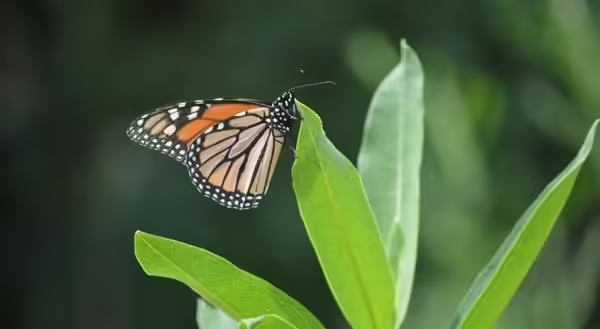
There is something about mowing that is so satisfying.
What is it? The smell of cut grass? Taming an unruly landscape?
To me, it is measurable progress. It seems so often that modern jobs give few tangible results. So much of our work is in the digital ether. After a full day's work, I leave the office switching off my computer, and all my toiling vanishes with the click of a mouse.
At home, I seek tasks of visual permanence by working with my hands, cleaning, and of course mowing. The desire to mow often expands beyond the yard as many landowners also mow road banks and ditches.
However, the constant routine of mowing is harming the monarch butterfly, Danaus plexippus. Milkweed is the only plant that monarch caterpillars eat. Milkweed loss is one of the major causes of declining monarch populations.
How mowing affects monarch butterflies
Milkweed is a disturbance species, meaning disturbances such as prescribed burns or mowing can actually promote its growth. Milkweed is commonly found in areas such as ditches, road banks, and natural areas. But mowing these areas can be damaging if done during peak times of monarch reproduction and migration.
Mowing can be especially harmful in August and September when the final monarch generation of the year develops and migrates to their overwintering site in Mexico.
When should you mow
These dates are based on monarch breeding and migration activities. Mid-summer mowing can be done, but will still kill some monarchs.
- Southern Illinois: Those south of the 40-degree latitude line can mow before April 1 and after October 15. If necessary, you can also do a mid-summer mowing July 1 to July 20.
- Northern Illinois: Those north of the 40-degree latitude line can mow before May 1 and after October 1. A mid-summer mowing can take place June 30 to July 10.
Tips for mowing near habitats or roadsides
- Don't mow the entire area. Leave unmown strips to recolonize the cut areas.
- Avoid mowing at night when insects are inactive and cannot escape.
- Use a minimum cutting height of 8-12". This height removes seed production for many invasive plants while minimizing the impact to native plants.
- Use a flushing bar and mow slowly to allow wildlife to escape before the mower passes over.
Follow these mowing guidelines, can help preserve vital monarch habitat. Check out Monarch Joint Venture's brochure Mowing: Best practices for monarchs.
2018 Monarch Migration Festival
If you want to learn more about monarch butterflies, join us for our annual Monarch Migration Festival on September 8, 2018, at the Lakeside Nature Center in Galesburg, IL. It is a fun-filled day starting at 10 a.m. with activities for the whole family.
Events to expect at the festival:
- Real live monarch butterflies and caterpillars
- Ms. Mari Posa mobile classroom
- Send your own symbolic butterfly to Mexico
- Purchase native plants
- Seminar about beekeeping
- Talk to local conservation experts
- Build monarch rearing cages
- Dress up like a butterfly for the monarch parade at 2:30 p.m.
- Fill out an event passport to win a chance to release a butterfly
- Enjoy vendors, music, food, crafts, talks, and of course butterflies!
The festival ends at 3 p.m. with a final release of a roost of Monarch butterflies. For more information on monarch butterflies contact the Knox County Extension office at 309-342-5108 or visit our website at go.illinois.edu/Monarch.
The University of Illinois Extension will also be a guest booth at the Macomb Farmers' Market on September 22. Master Gardeners and Master Naturalists will teach youth through hands-on activities how they can help monarch butterflies.